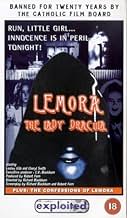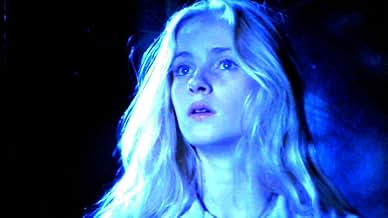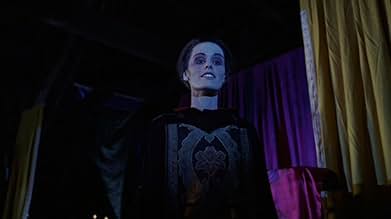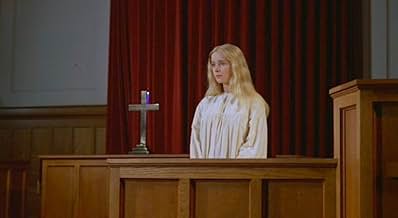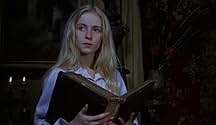Lemora la metamorfosi di Satana
Titolo originale: Lemora: A Child's Tale of the Supernatural
VALUTAZIONE IMDb
6,1/10
2692
LA TUA VALUTAZIONE
Aggiungi una trama nella tua linguaA young girl who returns to her hometown to see her dying father finds herself being drawn into a web of vampirism and witchcraft.A young girl who returns to her hometown to see her dying father finds herself being drawn into a web of vampirism and witchcraft.A young girl who returns to her hometown to see her dying father finds herself being drawn into a web of vampirism and witchcraft.
- Regia
- Sceneggiatura
- Star
Recensioni in evidenza
It isn't hard to see why 'Lemora' was condemned by the Catholic film society. It's the story of a pubescent girl's fall from innocence and her sexual awakening, told in a 'fairytale for adults' manner. There are some amoral scenes to sit through with hints of lesbianism between the child and her vampire tutor that occasionally come across as sleazy, especially when the pubescent girl is given a bath by Lemora ('What an exciting figure you have').
Ambitiously set in the 1920s, a gangster brutally murders his wife and her lover before disappearing into the country. His thirteen-year-old daughter, Lila Lee (played by Cheryl Smith*) is cared for by the Reverend Mueller (director, Blackburn), who secretly houses sensuous feeling for his little choirgirl. Lila is delighted when she receives a letter from the mysterious Lemora, detailing her father's deteriorating condition. Lemora demands that Lila be present at her father's bed immediately. Lila's journey to Lemora's hidden cottage, through dense dark woods is constantly plagued; firstly, by lecherous older men, then a psychopathic bus-driver and then a group of fanged beasts who chase her from the bus. The seductive Lemora's house is filled with children, all of whom are part of her growing legion of vampires. The Reverend has decided to admit his sordid desires to Lila and begins to search for her. You'd think that was enough plot development, but after this point more twists follow, which might confuse some viewers.
'Lemora', a late night TV favourite, is considered to be one of the classic vampire films of the early seventies, opposite 'Count Yorga, Vampire' (Bob Kelljan, 1970). There strong sexual overtones and the corruption of innocence storyline were the prime reasons why the Catholic Film Board wanted this film banned for almost twenty years. Due to its lack of budget, (poor sound and sketchy cinematography) and European feel, the film often looks like a porn film which doesn't help matters concerning the sexual connotations, but they're never really presented in a exploitative manner.
Ambitiously set in the 1920s, a gangster brutally murders his wife and her lover before disappearing into the country. His thirteen-year-old daughter, Lila Lee (played by Cheryl Smith*) is cared for by the Reverend Mueller (director, Blackburn), who secretly houses sensuous feeling for his little choirgirl. Lila is delighted when she receives a letter from the mysterious Lemora, detailing her father's deteriorating condition. Lemora demands that Lila be present at her father's bed immediately. Lila's journey to Lemora's hidden cottage, through dense dark woods is constantly plagued; firstly, by lecherous older men, then a psychopathic bus-driver and then a group of fanged beasts who chase her from the bus. The seductive Lemora's house is filled with children, all of whom are part of her growing legion of vampires. The Reverend has decided to admit his sordid desires to Lila and begins to search for her. You'd think that was enough plot development, but after this point more twists follow, which might confuse some viewers.
'Lemora', a late night TV favourite, is considered to be one of the classic vampire films of the early seventies, opposite 'Count Yorga, Vampire' (Bob Kelljan, 1970). There strong sexual overtones and the corruption of innocence storyline were the prime reasons why the Catholic Film Board wanted this film banned for almost twenty years. Due to its lack of budget, (poor sound and sketchy cinematography) and European feel, the film often looks like a porn film which doesn't help matters concerning the sexual connotations, but they're never really presented in a exploitative manner.
Never had heard of this one before, and I assumed it would just be a low-budget snoozer - but it's not! It's pretty damn good! Angelic girl leaves her church to find her murderous dad so she can forgive him and finds herself involved with vampires instead. Very well shot and quite creepy. This deserves more attention. Plenty of tension; it feels like there's something supernatural and terrifying around every corner. Cheryl Smith made her debut here - she would later adopt the professional nickname Rainbeaux and briefly play with the Runaways band.
Looking at the packaging to this lost classic, I was expecting a real crummy slice of early 70's schlock, hence why I took so long to actually put the tape into the VCR, so it was a total surprise when it turned out to be a genuinely very haunting, beautifully made creepfest.
The plot's fairly simple, for anyone who hasn't seen it, involving as it does a pure-as-the-driven snow church girl, Lila Lee, (of an unspecified age but I'm guessing around 13/14?) who receives a letter from the mysterious "Lemora" asking her to come out to some remote town in the middle of nowhere to see her long-lost gangster Father as he lies on his deathbed. Needless to say, Lemora is not all she appears to be and the mysteries surrounding her ominous precense unfold slowly but with a powerfully creepy vibe throughout the film's running time.
I was really taken aback by the care which appeared to go into making the film - the soundtrack, both musically and (more to the point) the sound effects themselves, were magnificently done with lots of 'night time' sounds quite high in the mix and some really appropriately done 'scare' noises, such as a scene in which Lila is attacked by a ghoul after taking a bath, which is punctuated by an intense high-pitched shrieking noise getting progressively higher in pitch as the scene goes on... it's maybe not the smartest trick in the book but it makes the scene a *LOT* more effective and it's little touches like this which made the movie. Same goes for the imagery, which is often very surreal and frightening. Much of the film is shot in the dark and usually if something comes out of the shadows, it's something horrible that you don't want to see! There are some beautifully done shots though, such as the one in which Lila discovers Lemora's vampirism by watching her through the window as she bites a young child - the way the shot is set up, I thought was very nicely done indeed... It may not be Mario Bava but then, if it was, it'd probably not be anywhere near as affecting - there's something about the subtlety of the film which gives it a low-key, moody edge.
There's very little gore, no real nudity and nothing that smacks of the exploitation clichés the packaging suggests. The much-touted 'lesbianism' angle on the back of the box is played as merely a quiet subtext, adding yet another pleasingly understated edge to the movie.
I dunno *just* how obscure this movie is, but it definitely doesn't deserve to be. I was very very impressed - it's a dark fairytale in the same vein as some of Jean Rollin's stuff but with a much more coherent narrative, none of the more explicit 'erotic' elements and a strange innocence to it which makes it all the creepier... Most of the film is seen through a child's eyes and many of the scares play on childhood fears, or at least things that would've creeped *me* out tremendously as a child and still lurk around at the back of 'ye olde braine'... There's little moments, like when Lila wakes up in 'the stone room' and looks through the bars to see laughing, dancing shadows behind the curtains in the mansion window nearby... urrgh, difficult to even explain why, but things like this *REALLY* give me the shivers. That probably sounds crass and silly the way I've written it, but trust me on this one, "Lemora" is one seriously unnerving little gem of a film and a must for anyone into horror cinema IMHO.
The plot's fairly simple, for anyone who hasn't seen it, involving as it does a pure-as-the-driven snow church girl, Lila Lee, (of an unspecified age but I'm guessing around 13/14?) who receives a letter from the mysterious "Lemora" asking her to come out to some remote town in the middle of nowhere to see her long-lost gangster Father as he lies on his deathbed. Needless to say, Lemora is not all she appears to be and the mysteries surrounding her ominous precense unfold slowly but with a powerfully creepy vibe throughout the film's running time.
I was really taken aback by the care which appeared to go into making the film - the soundtrack, both musically and (more to the point) the sound effects themselves, were magnificently done with lots of 'night time' sounds quite high in the mix and some really appropriately done 'scare' noises, such as a scene in which Lila is attacked by a ghoul after taking a bath, which is punctuated by an intense high-pitched shrieking noise getting progressively higher in pitch as the scene goes on... it's maybe not the smartest trick in the book but it makes the scene a *LOT* more effective and it's little touches like this which made the movie. Same goes for the imagery, which is often very surreal and frightening. Much of the film is shot in the dark and usually if something comes out of the shadows, it's something horrible that you don't want to see! There are some beautifully done shots though, such as the one in which Lila discovers Lemora's vampirism by watching her through the window as she bites a young child - the way the shot is set up, I thought was very nicely done indeed... It may not be Mario Bava but then, if it was, it'd probably not be anywhere near as affecting - there's something about the subtlety of the film which gives it a low-key, moody edge.
There's very little gore, no real nudity and nothing that smacks of the exploitation clichés the packaging suggests. The much-touted 'lesbianism' angle on the back of the box is played as merely a quiet subtext, adding yet another pleasingly understated edge to the movie.
I dunno *just* how obscure this movie is, but it definitely doesn't deserve to be. I was very very impressed - it's a dark fairytale in the same vein as some of Jean Rollin's stuff but with a much more coherent narrative, none of the more explicit 'erotic' elements and a strange innocence to it which makes it all the creepier... Most of the film is seen through a child's eyes and many of the scares play on childhood fears, or at least things that would've creeped *me* out tremendously as a child and still lurk around at the back of 'ye olde braine'... There's little moments, like when Lila wakes up in 'the stone room' and looks through the bars to see laughing, dancing shadows behind the curtains in the mansion window nearby... urrgh, difficult to even explain why, but things like this *REALLY* give me the shivers. That probably sounds crass and silly the way I've written it, but trust me on this one, "Lemora" is one seriously unnerving little gem of a film and a must for anyone into horror cinema IMHO.
This highlight of seventies horror cinema is a vibrant and lush Gothic fairytale story of a young girl's odyssey as she searches for her father in a world of vampires and demons that wont hesitate to take her innocence at any opportunity that they get. Richard Blackburn's film takes influence from a number of sources across both film and literature, but in spite of this; the writer-director has managed to mould together a tale that is both haunting and original. The story follows Lila Lee, the daughter of a notorious gangster who, after finding his wife in bed with another man, proceeds in blowing both her and her lover to bits. Shortly after her father had fled the town to avoid the law, Lila Lee receives a letter telling her that her father is on his deathbed and wants her to come and see him. Only thing is, this letter is signed 'Lemora'. The film plays out like an offbeat coming of age drama, with the innocent young Lila Lee learning that all is not as it seems, and that danger lurks around every corner. The supernatural elements serve brilliantly as a metaphor for the similar dangers in real life.
The acting in Lemora clearly isn't the most important aspect of the film, but there are still some notable performances on display. Cheryl Smith takes the lead role as the angelic Lila Lee, and completely looks the part as a bewildered young girl in the centre of a world she knows nothing about. The title role of 'Lemora' is taken by Lesley Gilb. This actress doesn't have a film credit to her name after this film, and it's not really surprising as despite looking the part; her performance is wooden in the extreme. Writer-director Richard Blackburn is surprisingly effective in his small role as a reverend. He completely convinces as the odd god fearing preacher. Really, though, it's the more aesthetic elements of the film that rule; and the atmosphere and the make-up are absolutely excellent. The nighttime filming helps to create a sense of danger at every turn, and brilliantly compliments the fear that the child at the centre of the story is feeling. The make-up is effectively done, but not overdone; which makes the monsters feel very real despite their otherwise otherworldly appearance. Lemora, despite it's low budget and inexperienced crew, is a surprisingly professionally done film. While most films released at this point in time relied on high body counts and gore levels to draw audiences; Richard Blackburn has put the focus on story and atmosphere, and that is why Lemora is the enduring, albeit lost, classic that it is today.
The acting in Lemora clearly isn't the most important aspect of the film, but there are still some notable performances on display. Cheryl Smith takes the lead role as the angelic Lila Lee, and completely looks the part as a bewildered young girl in the centre of a world she knows nothing about. The title role of 'Lemora' is taken by Lesley Gilb. This actress doesn't have a film credit to her name after this film, and it's not really surprising as despite looking the part; her performance is wooden in the extreme. Writer-director Richard Blackburn is surprisingly effective in his small role as a reverend. He completely convinces as the odd god fearing preacher. Really, though, it's the more aesthetic elements of the film that rule; and the atmosphere and the make-up are absolutely excellent. The nighttime filming helps to create a sense of danger at every turn, and brilliantly compliments the fear that the child at the centre of the story is feeling. The make-up is effectively done, but not overdone; which makes the monsters feel very real despite their otherwise otherworldly appearance. Lemora, despite it's low budget and inexperienced crew, is a surprisingly professionally done film. While most films released at this point in time relied on high body counts and gore levels to draw audiences; Richard Blackburn has put the focus on story and atmosphere, and that is why Lemora is the enduring, albeit lost, classic that it is today.
The late and sorely missed Cheryl Smith stars as Lila, the lovely pubescent daughter of a notorious gangster, who is being fostered by a kind-hearted minister. Unaware of her father's whereabouts and concerned for his well-being, she receives a letter indicating that he lays ailing in a mapped location, and should she choose to visit him, then she must do so alone. Thus begins Lila's dark odyssey...from the minute she steps away from the familiar safety of her front door, her nest of childhood innocence is given way to a bleak and frightening world fraught with drunks, strumpets, and lecherous men...but a corporeity of a far more uncanny and sinister nature awaits her at her journey's end...the mysterious letter she received was a siren-song luring her to the incommunicado home of Lemora, a vampiress with an appetence for the blood of youths. This ancient, statuesque creature resides with her cackling old charlady and a mottle of emaciated children in a dark swampland where savage ghouls prowl the night.
The bizarre nexus ensuingly forged between Lemora and Lila is simultaneously horrific and erotically charged...the small-framed, willowy Lila futilely resisting, though apprehensively drawn to, the imposing and mysterious Lemora. It's an arousing 'butch/femme' dynamic which works well, and is illustrated more intricately than most examples of the gratis lesbiana inclusive to vampire cinema.
An artfully executed celestial nightmare with subtexts touching on religious hypocrisy and elegiac loss of innocence, LEMORA demonstrates perfectly how integrity, creativity, and resourcefulness can compensate heartily for dearth of funds in a motion picture production.
Superior. 9/10.
The bizarre nexus ensuingly forged between Lemora and Lila is simultaneously horrific and erotically charged...the small-framed, willowy Lila futilely resisting, though apprehensively drawn to, the imposing and mysterious Lemora. It's an arousing 'butch/femme' dynamic which works well, and is illustrated more intricately than most examples of the gratis lesbiana inclusive to vampire cinema.
An artfully executed celestial nightmare with subtexts touching on religious hypocrisy and elegiac loss of innocence, LEMORA demonstrates perfectly how integrity, creativity, and resourcefulness can compensate heartily for dearth of funds in a motion picture production.
Superior. 9/10.
Lo sapevi?
- QuizNotably similar to the story Carmilla by Sheridan Le Fanu in which a female seduces a teenage girl. Towards the end of the film Lemora indicates that she has had many names.
- BlooperWhen Lila is first taken into the house by Lemora, she is told to go upstairs to her room. Lemora says "It is the first open door at the end of the hall." But when Lila goes upstairs ALL of the doors are closed.
- ConnessioniFeatured in Movie Macabre: Lemora A Child's Tale of the Supernatural (1983)
- Colonne sonorePaper Angel
Sung by The Black Whole
I più visti
Accedi per valutare e creare un elenco di titoli salvati per ottenere consigli personalizzati
- How long is Lemora: A Child's Tale of the Supernatural?Powered by Alexa
Dettagli
- Data di uscita
- Paese di origine
- Lingua
- Celebre anche come
- Lemora: A Child's Tale of the Supernatural
- Luoghi delle riprese
- Phillips Mansion - 2640 W. Pomona Boulevard, Pomona, California, Stati Uniti(Lemora's house exteriors)
- Azienda produttrice
- Vedi altri crediti dell’azienda su IMDbPro
Contribuisci a questa pagina
Suggerisci una modifica o aggiungi i contenuti mancanti

Divario superiore
By what name was Lemora la metamorfosi di Satana (1973) officially released in India in English?
Rispondi

